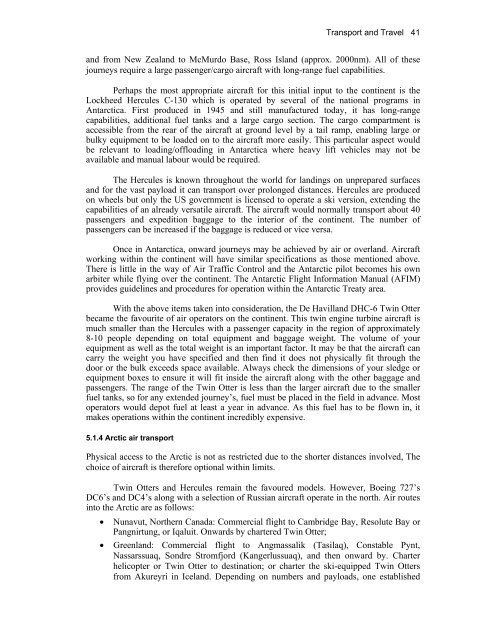Edited by Rachel Duncan 4th Edition ISBN 0-907649-91-2 London ...
Edited by Rachel Duncan 4th Edition ISBN 0-907649-91-2 London ...
Edited by Rachel Duncan 4th Edition ISBN 0-907649-91-2 London ...
You also want an ePaper? Increase the reach of your titles
YUMPU automatically turns print PDFs into web optimized ePapers that Google loves.
Transport and Travel 41<br />
and from New Zealand to McMurdo Base, Ross Island (approx. 2000nm). All of these<br />
journeys require a large passenger/cargo aircraft with long-range fuel capabilities.<br />
Perhaps the most appropriate aircraft for this initial input to the continent is the<br />
Lockheed Hercules C-130 which is operated <strong>by</strong> several of the national programs in<br />
Antarctica. First produced in 1945 and still manufactured today, it has long-range<br />
capabilities, additional fuel tanks and a large cargo section. The cargo compartment is<br />
accessible from the rear of the aircraft at ground level <strong>by</strong> a tail ramp, enabling large or<br />
bulky equipment to be loaded on to the aircraft more easily. This particular aspect would<br />
be relevant to loading/offloading in Antarctica where heavy lift vehicles may not be<br />
available and manual labour would be required.<br />
The Hercules is known throughout the world for landings on unprepared surfaces<br />
and for the vast payload it can transport over prolonged distances. Hercules are produced<br />
on wheels but only the US government is licensed to operate a ski version, extending the<br />
capabilities of an already versatile aircraft. The aircraft would normally transport about 40<br />
passengers and expedition baggage to the interior of the continent. The number of<br />
passengers can be increased if the baggage is reduced or vice versa.<br />
Once in Antarctica, onward journeys may be achieved <strong>by</strong> air or overland. Aircraft<br />
working within the continent will have similar specifications as those mentioned above.<br />
There is little in the way of Air Traffic Control and the Antarctic pilot becomes his own<br />
arbiter while flying over the continent. The Antarctic Flight Information Manual (AFIM)<br />
provides guidelines and procedures for operation within the Antarctic Treaty area.<br />
With the above items taken into consideration, the De Havilland DHC-6 Twin Otter<br />
became the favourite of air operators on the continent. This twin engine turbine aircraft is<br />
much smaller than the Hercules with a passenger capacity in the region of approximately<br />
8-10 people depending on total equipment and baggage weight. The volume of your<br />
equipment as well as the total weight is an important factor. It may be that the aircraft can<br />
carry the weight you have specified and then find it does not physically fit through the<br />
door or the bulk exceeds space available. Always check the dimensions of your sledge or<br />
equipment boxes to ensure it will fit inside the aircraft along with the other baggage and<br />
passengers. The range of the Twin Otter is less than the larger aircraft due to the smaller<br />
fuel tanks, so for any extended journey’s, fuel must be placed in the field in advance. Most<br />
operators would depot fuel at least a year in advance. As this fuel has to be flown in, it<br />
makes operations within the continent incredibly expensive.<br />
5.1.4 Arctic air transport<br />
Physical access to the Arctic is not as restricted due to the shorter distances involved, The<br />
choice of aircraft is therefore optional within limits.<br />
Twin Otters and Hercules remain the favoured models. However, Boeing 727’s<br />
DC6’s and DC4’s along with a selection of Russian aircraft operate in the north. Air routes<br />
into the Arctic are as follows:<br />
• Nunavut, Northern Canada: Commercial flight to Cambridge Bay, Resolute Bay or<br />
Pangnirtung, or Iqaluit. Onwards <strong>by</strong> chartered Twin Otter;<br />
• Greenland: Commercial flight to Angmassalik (Tasilaq), Constable Pynt,<br />
Nassarssuaq, Sondre Stromfjord (Kangerlussuaq), and then onward <strong>by</strong>. Charter<br />
helicopter or Twin Otter to destination; or charter the ski-equipped Twin Otters<br />
from Akureyri in Iceland. Depending on numbers and payloads, one established

















